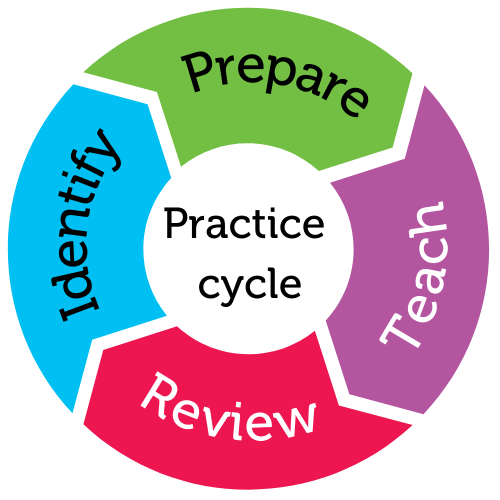
For student year
Helps students to
- improve confidence
- improve test performance
- decrease exam anxiety
Helps teachers to
- facilitate performance
Summary
Do you have students who have anxiety, lack confidence about tests, avoid taking tests, or underperform during tests?
Examinations require far more skills that just the subject content learnt during the unit of study. These skills can be difficult for students with executive functioning difficulties, including those on the autism spectrum. Teaching these skills before the exam can help students to be more confident, feel less anxious and perform better on the test.
Australian Professional Standards for Teachers related to this practice
1.6 - strategies to support the full participation of students with disability
2.3 - curriculum, assessment and reporting
4.2 - manage classroom activities
For further information, see Australian Professional Standards for Teachers AITSL page
Preparing to teach
Examination skills
Successfully completing exams requires students to have exam strategies and skills as well as content knowledge. These skills include:
- allocating time appropriately
- managing time within the test
- understanding what is important within a question
- understanding how to answer a variety of question types
- understanding the weighting of questions
- knowing how to break down complex questions
- knowing how to review answers to questions
- knowing to attempt questions even if unsure.
They are important skills for all students to learn when at school and you can explicitly teach them to students.
Explicit teaching and practice of testing skills (rather than being told about them), helps students to become competent in testing situations and alleviate some of the anxieties associated with timed assessments.
Identify skills
Embed testing skills students will require for upcoming tests into your lesson planning. Provide opportunities for them to practice these skills in their lessons.
These may include providing practice tests where students practice skills such as:
- understanding different question types (e.g. multiple-choice, true/false, fill-in-the-blank, short answer, extended written response)
- breaking down questions - what are the questions asking. Make sure students are aware of the different types of tasks - explain, list, describe etc. This will help them to answer the questions properly
- highlighting key parts of the question - encourage students, where possible to highlights the different prats of the questions. You may like to highlight the key parts on practice questions to help teach students what to look for.
- attempting questions even when unsure of the answer - encourage student to attempt questions they are unsure of rather than leaving questions unanswered
- reviewing answers if possible - remind students to plan for time at the end of the exam to review their answers and ensure they have answered all the questions.
You may also like to provide students with an exam strategy such as
- Write their name on the test- encourage students to make this the first thing they do. This simple action provides a starting point.
- Identify the relevant information and instructions - where are questions to be answered; - do all sections need to be completed
- Identify the time allocated for the test- knowing how long the test will take will assist students in managing and planning their time.
- Identify the sections and number of questions in the test - some sections may require more time than others; - work with students to plan time for multiple choice, essay and paragraphs etc. Understanding and using the weighting of different test parts will help them to plan how much time to spend on each part.
It works better if…
- students have multiple opportunities to practice applying test-taking strategies
- teachers provide direct feedback to students on their test-taking strategies
- students understand the aids they can use during tests, e.g., calculators or mathematical formulas
- students use a mnemonic test-taking learning strategy, e.g., PIRATES (see Resources section below)
- teachers regularly review test-taking strategies with students
It doesn’t work if…
- instruction in test-taking strategies draws negative attention to students who experience difficulties
- difficulties with test-taking are noticed and commented on more often than improvements or the successful use of strategies
In the classroom
How do I do it?
Exam approaches
- Before you start the test, ensure you explicitly outline instructions.
- remind students to use their exam strategy
- remind students to read the instructions and plan their time
- write the time on the board - start and finish and display the time left on the board with 20 minute intervals (or other appropriate intervals)
- Before the end of the test give students 15 minute or 10 minute warnings that the test is about to end
- At the end of the test remind students to ensure their name is on the paper.
Review
- Positively reinforce student use of test-taking strategies
- Identify any ongoing difficulties with test-taking
- Provide further practice in continued areas of difficulty.
Practice toolkit
Practice implementation planner template
We know it's not always easy to keep track of what's working and what isn't. So, we've created this template for you to record and reflect on what you're doing to create more inclusive classrooms. The implementation planner contains:
- guidance around goal setting
- a reflection section (what worked, didn’t work, what to change, and next steps)
- prompting questions.
Implementation planner with examples
Set your professional learning goal for:
Develop exam preparation skills
Benefits of goal setting
Setting, working towards, and reflecting on goals helps you grow professionally and improve your practice. You can access AITSL learning resources for teachers to learn more about:How to set goals
The Australian Institute for Teaching and School Leadership recommends using the SMART matrix to frame your goal setting.SMART goals refers to goals that are:
- Specific
- Measurable
- Achievable
- Relevant
- Time-phased
Resources
Related Practices

Create assignment exemplars
TEACHING PRACTICE
For student years
Helps students to
- understand the task
- build confidence
This practice is from the core research project
Learning Cycle

